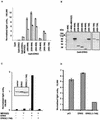ERK5 is a novel type of mitogen-activated protein kinase containing a transcriptional activation domain
- PMID: 11046135
- PMCID: PMC102145
- DOI: 10.1128/MCB.20.22.8382-8389.2000
ERK5 is a novel type of mitogen-activated protein kinase containing a transcriptional activation domain
Abstract
Previous studies have shown that upregulation of the orphan steroid receptor Nur77 is required for the apoptosis of immature T cells in response to antigen receptor signals. Transcriptional upregulation of Nur77 in response to antigen receptor signaling involves two binding sites for the MEF2 family of transcription factors located in the Nur77 promoter. Calcium signals greatly increase the activity of MEF2D in T cells via a posttranslational mechanism. The mitogen-activated protein (MAP) kinase ERK5 was isolated in a yeast two-hybrid screen using the MADS-MEF2 domain of MEF2D as bait. ERK5 resembles the other MAP kinase family members in its N-terminal half, but it also contains a 400-amino-acid C-terminal domain of previously uncharacterized function. We report here that the C-terminal region of ERK5 contains a MEF2-interacting domain and, surprisingly, also a potent transcriptional activation domain. These domains are both required for coactivation of MEF2D by ERK5. The MEF2-ERK5 interaction was found to be activation dependent in vivo and inhibitable in vitro by the calcium-sensitive MEF2 repressor Cabin 1. The transcriptional activation domain of ERK5 is required for maximal MEF2 activity in response to calcium flux in T cells, and it can activate the endogenous Nur77 gene when constitutively recruited to the Nur77 promoter via MEF2 sites. These studies provide insights into a mechanism whereby MEF2 activity can respond to calcium signaling and suggest a novel, unexpected mechanism of MAP kinase function.
Figures





References
-
- Blaeser F, Ho N, Prywes R, Chatila T A. Ca(2+)-dependent gene expression mediated by MEF2 transcription factors. J Biol Chem. 2000;275:197–209. - PubMed
-
- Calnan B, Szychowski S, Chan F K M, Cado D, Winoto A. A role of the orphan steroid receptor Nur77 in antigen-induced negative selection. Immunity. 1995;3:273–282. - PubMed
Publication types
MeSH terms
Substances
Grants and funding
LinkOut - more resources
Full Text Sources
Other Literature Sources
Research Materials
Miscellaneous
